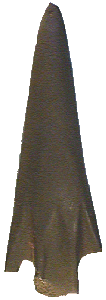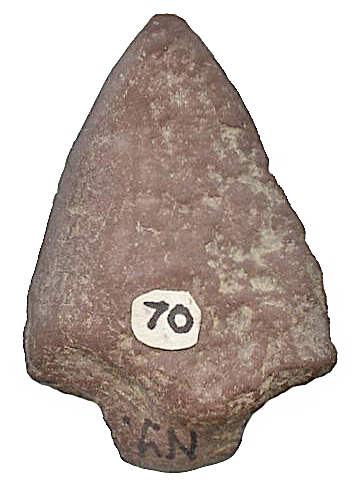



Point Type: SLATE
- Ground & Polished
Also See:
Location: Northeast United States & Eastern Canada
Associated Dates:
unknown
Morphology: Stemmed
General Description: The ground and polished Slate artifact represents a manufacturing technique which is quite different than knapping. Flints and cherts are very hard to find in New England as those stones are not abundant in the region. The New England aboriginal natives used slate, siltstone and quartz in the place of flint and chert for many points and tools however ground slate points are not common. Using abrasion techniques with rudimentary knapping and chipping, forms were ground into tools, knives and projectile points. Some points have a very high polish others do not. Some artifacts can be attributed to a point type. Those on this page however remain unclassified or untyped.
In 1909, Professor G. H. Perkins of the University of Vermont describes the Lake Champlain type of ground point in the American Anthropologist, Oct-Dec Vol. 2, No. 4, p.607: "Although resembling the chipped points or knives in their general form, certain smooth objects are found which are quite different in material from the average; being ground and not chipped. These represent a class of implement which are found on both sides of Lake Champlain. They are all made from slate, red, purple, or drab, such as occurs abundantly in the region. The use of these objects is rather problematical. They almost always are well made, the surface is smooth and almost polished, the edges are sharp and do not indicate that the tool had been severely treated. And yet the material is not very hard and is very brittle, and some of the specimens (knives?) are slender. One is nine inches long and an inch and a half wide at the widest part; it would easily break, and there are other specimens nearly as fragile. The greater number of these are three or four inches long and of varying width. All are stemmed, and usually the stem is notched on each side. In the collection at Burlington, VT, there are more than 30 of these objects, and a smaller number in the state's collection in Montpelier, VT."
I am unaware of any typology for ground slate points. If you have any information about ground slate points please contact me via e-mail.
About the Point Above (Left): The point picture above on the left is a surface find from coastal Massachusetts. It is made from a black slate that has been ground an polished. The point must have had barbs at one time however they have been struck off and lost at some time in the point's history. A stem, also snapped off, was present and a pointed, ground, concavity in the hafting area is well suited for a shaft. The concavity is present on both faces. The point measures 74 mm in length, it is 6 mm thick and the shoulders are 24 mm wide. The stem stub is 9 mm long at present and is tapered to a thickness of 3 mm within the ground, concave hafting channel. The entire point is silky smooth and certainly a large amount of time and care went into its manufacture. One can only imagine its original outline form with extended barbs. Catalog Number 54-65-C
About the Point Above (Right): The point pictured above on the right is a potato field surface find from a farm on the outskirts of the town of Stoney Brook, Suffolk County, Long Island, New York. It was found by my father back in the late 1930's while visiting his grandparent's farm. It is made from a blackish brown slate that has been ground an mildly polished. The point has an contracting stem at the basal end. This point resembles the southeastern Morrow Mountain type however that type is never found as far north as north shore of Long Island. The point measures 40 mm in length, it is 6 mm thick and the shoulders are 28 mm wide. The stem is 4 mm long and is tapered to a thickness of 3 mm. The entire point is smooth and some amount of time and care went into its manufacture. I wonder why a native would fashion a point in a design that is not typical for the region? Certainly some amount of inventiveness had to be present for this point to crafted in its outline. Catalog Number 70-6-A
References: Fogelman, Moorehead
© Copyright 1997 - 2008 LITHICS-Net WWW.LITHICSNET.COM
Use Your Browser's BACK Button to Return to the LITHICS-Net Index.